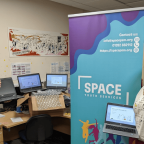
A hybrid education format: how to improve the model
In the past year, the learning experience has been completely transformed. From sitting in a classroom environment to coming to a juncture where students and instructors interact in an online environment, the classroom delivery mechanism is different now!
Due to the COVID-19 pandemic, many schools and universities had to switch their classes to the online model. Many thought that this was just a short-term arrangement but eventually, schools realized the benefits of integrating the online learning environment with their traditional- known as a 'hybrid education model.'
What is a hybrid learning model?
The hybrid learning model uses the best mix of online and offline resources to make learning a seamless experience. Classes are conducted both in lecture halls and on online platforms like Zoom. Hybrid learning offers greater flexibility and features than traditional classroom lectures. For students, it offers the flexibility to schedule learning and for instructors, it helps them to introduce informative resources. It also makes it possible for instructors to monitor student activity during examinations by taking the help of online proctoring software.
To make the hybrid model effective, comprehensive planning is required to establish a sophisticated education framework. The model should take care of all the diverse elements of education. Only then can it be successful in making learning engaging and productive.
Here are 6 ways in which the hybrid model can be made effective.
1) Building a comprehensive course content
Many think that simply uploading offline lectures to the online medium will facilitate effective learning but this is not true. Hybrid courses should be viewed differently from traditional classroom courses. Course timings, syllabus, and activities should be designed to take advantage of both online and offline teaching.
For example, when deciding about individual modules, you should think about which is a better way of transmitting learning:
- Instructor-led sessions
- Digital resources
- Real-time vs flexible timing
Self-explanatory modules could be handed over in digital format to students and those that require an in-depth understanding should be facilitated through instructor-led sessions. This will help to make optimum utilization of resources and ensure students have access to a wide range of resources.
2) Interactive Learning
Once the course content is structured, efforts should be made into developing interactive learning experiences. The flexibility that hybrid learning provides should be used to make interactions an integral part of the learning exercise. Interactions help to clear doubts and also enhance concepts. Discussions, emails, announcements, and group work can be effective means of interactions. A blend of online and in-classroom interactions should be conducted to provide the best results.
3) Encourage student participation
In a hybrid model, the instructor can enable students to control how learning is conducted. For example, before beginning a module, the instructor can do a survey to understand how the student wants the classes to be conducted. Instructors can also create online discussion forums to allow students to share academic resources and personal experiences that can help each other. This encourages student participation and also helps them to feel responsible.
4) Use More Digital Resources
Creating digital resources like virtual labs and gamification can help engage learners. They help to enhance the interest of students and propels them to self-learn. Students can use information from classroom learning and see how they react to practical situations while playing educational games. They will get to know how their decisions will impact the outcomes. If desired, gamification can also be used as an effective progress monitoring tool.
5) Make examinations more secure
In an online environment, establishing examination rules is one thing, and ensuring they are followed is another. The disparity in student teacher-ratio and the use of sophisticated technology can make it difficult for instructors to watch how the students are following the examination guidelines. This can be solved by using a proctoring software.
Online proctoring software monitors resources like a computer desktop and webcam audio and video to check student activity. The activities on the students' computer are recorded and then transferred for review which helps instructors to identify violations of exam guidelines and take disciplinary action.
You may face problems in the beginning but your aim should be to continuously improve the model. Taking feedback from students and instructors can help identify the drawbacks and implement corrective measures. Even before COVID-19, a report in 2019 cited that the global education market will reach 350 billion USD by 2025. What this means is that the industry will see significant investments and innovations which will eventually translate into solutions for existing problems. This will further help you in making your hybrid education model more effective.

















